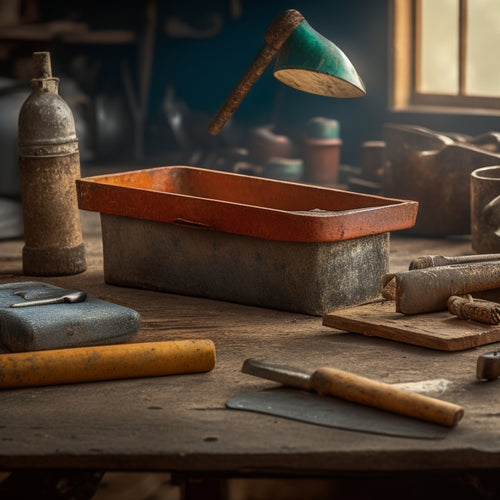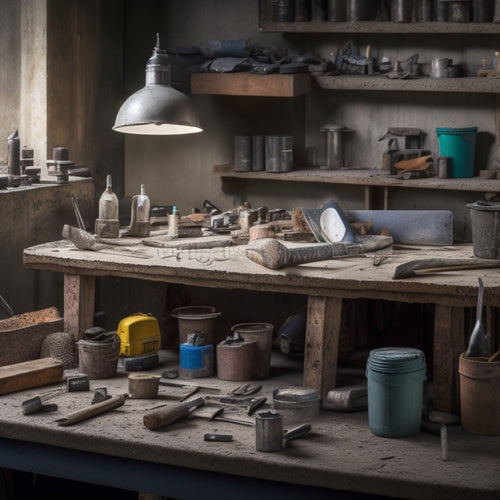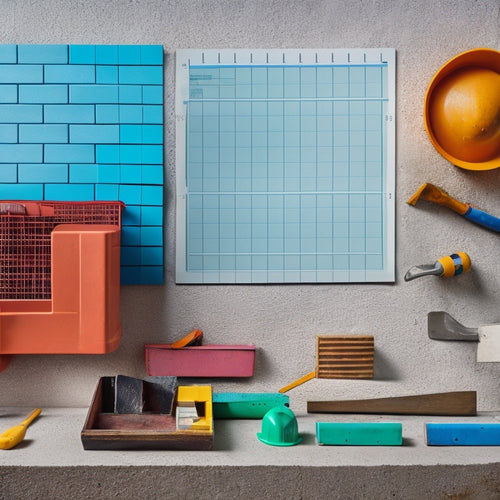
5 Best Concrete Blocklaying Tools for Beginners
Share
You'll need a solid set of tools to tackle your concrete blocklaying project. Start with essential trowels like pointed, square-edged, rounded-edge, and finishing trowels for scooping, spreading, and leveling mortar. Next, invest in levels and alignment tools, such as laser levels and alignment strings, to guarantee precise leveling and straight courses. Don't forget safety gear like protective eyewear, durable gloves, steel-toed boots, and a dust mask. Rounding out your toolkit are measuring and marking tools, like a high-quality measuring tape and chalk line, and core drilling and chiseling tools, including diamond-coated and carbide-tipped core drills. With these tools, you'll be well-equipped to take on your project and uncover the secrets to achieving flawless blocklaying results.
Key Takeaways
• Invest in a high-quality pointed trowel for scooping and transferring mortar effectively.
• Ensure you have a laser level with durability features like waterproofing and long battery life for precise leveling.
• Wear essential safety gear, including protective eyewear, durable gloves, and steel-toed boots, to prevent injuries.
• Use a combination of measuring tape and chalk line for accurate measurements and markings.
• Start with basic core drilling and chiseling techniques, and practice on scrap concrete blocks to build confidence and proficiency.
Essential Trowels for Blocklaying
You'll need a range of trowels to effectively lay concrete blocks, starting with a pointed trowel for scooping and transferring mortar. This trowel type is ideal for filling gaps and applying mortar to the block's surface.
Next, you'll require a square-edged trowel for spreading and leveling mortar. Its flat edge helps to achieve a smooth, even finish. A rounded-edge trowel is also necessary for applying mortar to curved or irregular surfaces.
Don't forget a finishing trowel, used to smooth out the mortar and remove excess material.
Proper trowel maintenance is vital to guarantee your tools last and perform well. Regularly clean your trowels with soap and water to prevent mortar buildup. Use a wire brush to remove stubborn debris and apply a rust inhibitor to prevent corrosion.
Store your trowels in a dry place, away from direct sunlight. By mastering the use and care of these essential trowel types, you'll be well on your way to achieving professional-looking results in your concrete blocklaying projects.
Levels and Alignment Tools
As you progress from preparing mortar to laying concrete blocks, guaranteeing accurate leveling and alignment becomes vital, and that's where levels and alignment tools come into play. You can't afford to compromise on precision, as even slight deviations can lead to structural issues and affect the overall aesthetic of your project.
Laser levels are a game-changer in this regard. They project a precise leveling line or spot, allowing you to quickly identify any deviations from the desired plane. This is especially useful when working with large surfaces or complex layouts. Look for a laser level that's durable, waterproof, and has a long battery life to guarantee uninterrupted workflow.
In addition to laser levels, alignment strings are another vital tool for achieving accurate alignment. By stretching these strings between reference points, you can create a visual guide for your blocklaying work. This helps you maintain consistent spacing, guarantee straight courses, and detect any deviations from the desired alignment.
Safety Gear for Beginners
With precise leveling and alignment in place, your focus shifts to safeguarding yourself from the physical demands and potential hazards associated with concrete blocklaying, making safety gear a non-negotiable component of your toolkit. As a beginner, it's crucial to prioritize your well-being and invest in the right protective equipment.
Here are the must-haves for your safety arsenal:
| Safety Gear | Description |
|---|---|
| Protective Eyewear | Shields your eyes from debris, dust, and chemical splashes |
| Durable Gloves | Provides grip, protection, and comfort for your hands |
| Steel-Toed Boots | Safeguards your feet from heavy objects and sharp edges |
| Dust Mask | Filters out airborne particles and contaminants |
| First Aid Kit | Equips you with essentials for minor injuries and accidents |
Measuring and Marking Tools
Accurate measurements and markings are critical to a successful concrete blocklaying project, and that's where your measuring and marking tools come in.
As a beginner, it's crucial to have the right tools to guarantee precision and accuracy. A high-quality measuring tape is a must-have in your toolkit. Look for a tape that's durable, easy to read, and has a sturdy hook that can withstand the rigors of daily use.
When it comes to marking lines, a chalk line is an indispensable tool. This simple yet effective tool allows you to create straight, precise lines on your concrete blocks, guaranteeing that your courses are level and plumb.
To use a chalk line, simply stretch it between two points, snap it, and you'll have a clear, visible line to guide your blocklaying.
With a reliable measuring tape and chalk line, you'll be able to measure and mark your blocks with confidence, setting yourself up for success in your concrete blocklaying project.
Core Drilling and Chiseling
You'll need to make precise holes and cuts in your concrete blocks to accommodate pipes, wires, and other obstructions, and that's where core drilling and chiseling tools come into play.
As a beginner, it's crucial to understand the different core drill types and their applications. You'll need to choose between diamond-coated core drills for precise, high-torque drilling and carbide-tipped core drills for faster, more aggressive drilling.
When it comes to chiseling, you'll need to master various techniques to remove excess concrete and debris. Start with basic chiseling techniques like 'pointing' and 'edging' to remove small amounts of concrete, then move on to more advanced techniques like 'plugging' and 'channeling' for larger removals.
Remember to always use proper safety gear, including gloves, safety glasses, and a dust mask, when working with core drilling and chiseling tools.
Practice on scrap concrete blocks to develop your skills and build confidence before moving on to actual projects.
Frequently Asked Questions
What Type of Sand Is Best for Mixing With Cement?
When mixing cement, you'll want to choose the right type of sand to guarantee a strong bond.
You have two main options: sharp sand and soft sand.
Sharp sand, also known as grit sand, is ideal for mixing with cement as it provides a better bond.
Aim for a mixing ratio of 1 part cement to 3-4 parts sand, depending on the specific project requirements.
How Do I Prevent Concrete From Drying Too Quickly?
When working with concrete, you'll want to prevent it from drying too quickly to guarantee proper curing.
To do this, focus on water retention and employ effective curing methods. You can use a fog spray or mist to maintain a humid environment, slowing down evaporation.
Additionally, apply a curing compound to the surface to lock in moisture.
Can I Use a Drill for Mixing Concrete?
When it comes to mixing concrete, you'll want to choose the right drill for the job.
You can use a drill, but not just any drill will do. Opt for a heavy-duty drill with a mixing paddle attachment, like a hammer drill or an impact driver. These drill types are designed to handle the thick, heavy mixture.
Use a slow, controlled mixing technique to avoid introducing air pockets, and mix in small batches to prevent overheating.
Do I Need to Cure Concrete in Warm Weather?
When you're working with concrete in warm weather, you'll need to prioritize curing to prevent rapid drying and cracking.
You'll want to maintain a consistent temperature between 50°F and 85°F (10°C and 30°C) during the curing process.
To achieve ideal results, apply a curing compound or keep the concrete moist by misting it regularly.
This will guarantee proper hydration and strength development, even in warm weather conditions.
How Often Should I Clean My Blocklaying Tools?
When it comes to tool maintenance, you should clean your blocklaying tools regularly to prevent mortar buildup and extend their lifespan.
Aim to clean your tools at the end of each workday, or whenever you've finished a task.
Daily cleaning frequency is ideal, but if that's not possible, make sure to clean them at least every 2-3 days.
Conclusion
You've made it to the end of our concrete blocklaying tool guide!
With these high-quality tools in your arsenal, you'll be building walls like a pro in no time.
Remember, having the right gear is like having a superpower - it can make all the difference between a mediocre job and a masterpiece.
Don't settle for anything less; invest in the best and watch your blocklaying skills soar to new heights!
Related Posts
-

Smart Guide to Buying Used Concrete Hand Tools
You're about to buy used concrete hand tools, and you need to get it right. Dedicate time to identify the tools you n...
-

Top Tools for Concrete Repair Success
When it comes to concrete repair success, you'll need a well-stocked toolkit with essential hand tools like trowels, ...
-

Reinforcement Tools Checklist for Concrete Block Walls
You'll need a range of reinforcement materials, including horizontal and vertical rebar, fiber mesh, and anchor bolts...


